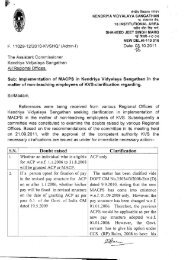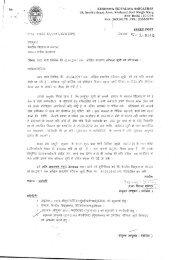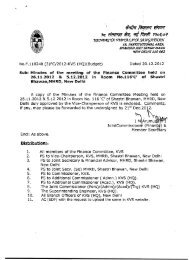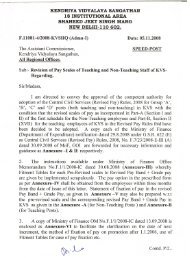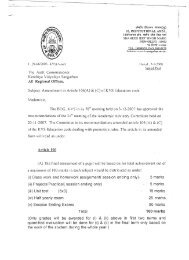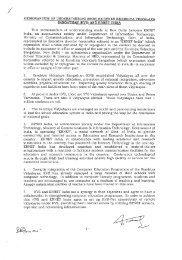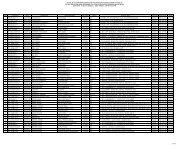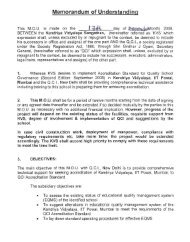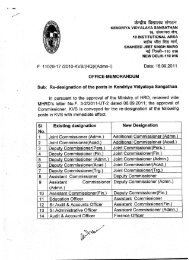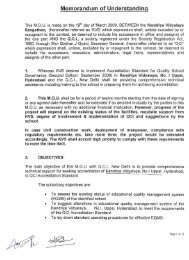expression ; DNA Fingerprinting ; Gene mapping ; Chromosome banding; Restriction enzyme,nucleotide sequence comparisons and homologies ; Molecular clocks ; Genetics in modernagriculture ,animal breeding, medicine, human behaviour ; Misuse of genetics ; GeneticCounseling ; Gene therapy ; HGP ; Gene Activity in prokaryotes and eukaryotes ; Signals <strong>for</strong>gene control – Hormones and growth factors ; Totipotency & Pleuripotency ; Stem cell andGene therapy ; Bacterial trans<strong>for</strong>mation, transduction and conjugation, Bacterial chromosome; Bacteriophages : Types, structure and morphology ;Evolutionary biology: Cosmic evolution –Physical basis of life ; Theories of origin of life ; Origin of life through biochemical evolution ;Experimental evidences <strong>for</strong> origin of life ; The origin of natural selection ; Extraterrestrial life ;Evolution of the eukaryotic cell : Evolution of the Metazoa ; Evolution of chordata and theevolution of the major vertebrate classes; Origin and evolution of man : Population Genetics;Genetic variations ; Polymorphism ; Gene frequency; Hardy Weinberg equilibrium ; Geneticdrift, founder effect ; adaptive radiations, ecological significance of molecular variations.<strong>Biology</strong> in Human welfareHealth and disease ; types of diseases, common diseases in humans ; Immunology – Innateand Acquired immunity ; Passive and active immunization ; Organization and structure oflymphoid organ ; Cells of the immune system and their differentiation ; Lymphocyte traffic ;Nature of immune response ; Structure and Functions of antibodies : Antigen-Antibodyinteractions ; Humoral immune response ; Cell mediated immunity ; Immunological memory ;Auto-immunity ; Allergies; HLA system in human :MHC haplotypes ; Transplantation types andproblems ; Immunodeficiency disorders ;etiology of HIV ; types, genetics and biochemistry ofcancer ; Drugs and alcohol abuse, Addiction , drug dependence, ill effects, prevention, itsabuse in adolescents and its management;Strategies <strong>for</strong> food production and enhancement:Animal husbandry, management of farm animals, breeding strategies ( natural and artificial)and their types, economic importance of each ; Plant breeding, method of release of newvariety, HYV of common cereals and pulses, bio-<strong>for</strong>tification, SCP ; Tissue culturing, somatichybridization;Microbes in Human Welfare: Technology associated and use of Microbes inhousehold, industries, medicine, bio-active molecules, sewage treatment and STP, Ganga andYamuna action plan, biogas production, biocontrol agents, biofertilizers.Principles of BiotechnologyGenetic engineering tools and technique, technique of separation and isolation of DNA, cloningvectors ,electrophoresis, bio reactors, processing of its products. Tissue engineering ;Cryopreservation ; Fusion methods, detection and applications of monoclonal antibodies, DNAvaccines, Edible vaccines.;Application in agriculture : GMO <strong>for</strong> pest resistance, RNAi anddsRNA technology,Application in Medicine, genetically engineered products, gene therapy.Molecular diagnosis : serum and urine analysis, PCR, ELISA ; Transgenic animals : theirphysiology, biological products and their use <strong>for</strong> testing the safety of vaccine and chemicals ;Bioethics issues ; biopyracy.EcologyOrganism and its environment, distribution of biomes, major physical factors and thephysiological responses shown by organisms ; Physical adaptation of plants and animals, rulesgoverning adaptations ; Population attributes and growth, logistic curves, Darwinian fitness ;Population interactions and their theories ; Ecosystem structure and functions, ecosystemproductivity and standing crop, decomposition in nature, energy flow in GFC / DFC, ecologicalpyramids, succession of community ; Nutrient cycle ; ecosystem services ; Biodiversity typesand its patterns, importance of diversity, its loss and their causes, conservation strategies ;Environmental issues : Types of pollution, their indicators, causes, effects, prevention andtreatment ; De<strong>for</strong>estation, recommended <strong>for</strong>estation, re<strong>for</strong>estation, case studies of people’sparticipation in conservation.
Introduction to Bio-technology<strong>Syllabus</strong> <strong>for</strong> <strong>written</strong> <strong>examination</strong> <strong>for</strong> <strong>PGT</strong>(BIOTECH)Historical perspectives, scope and importance, commercial potential , interdisciplinary challenge, aquantative approach-scale up – stages in commercialization of product and process, the fermenter ,aseptic operation. Manufacturing quality control, good manufacturing practices, good laboratorypractices, product safety, bio safety principles-environment and health risk , assessment, bio safetyregulatory guidelines and controlling agency, environmental law <strong>for</strong> hazardous drugs , microbes andGMO’S , Biotechnology related issues of Public concern, Bioethics. Marketing, Biotechnology in Indiaand global trends.Fundamentals of Biochemical engineering-Concept of pH , buffer , physical variables , dimensionsand units , measurement conventions , physical and chemical properties, data , stoichiometry , errorsin data and calculation, absolute and relative un certainty and types of error statistical analysispresentation of experimental data , data analysis , trends , testing mathematical models, goodness tofit , use of graph paper with logarithmic coordination and plotting of data process flow diagrams,material balance, fluid flow and mixing , mass transfer , heat transfer, unit operations, homogenousreactions , microbial growth , substrates utilization and product <strong>for</strong>mation kinetics, reactor engineering– rheology of fermentation fluids , scale up concepts, design of fermenting media, aseptic transfer,various microbial and enzyme reactors, instrumentation in bio reactors. Biotechnology and Society-Public perception of Biotechnology intellectual property, patents, reading a patent, Internationalscenario, National scenario, Varietals protection, ethical issues in agriculture and health care.BiochemistryBiomolecules- Structure and Dynamics; Thermodynamics: concept of free energy,entropyBuilding blocks of carbohydrates – sugars and their derivatives , chemical properties of sugar ,polysaccharides – glycogen , cellulose, chitin etc.Building blocks of proteins – Amino acids, Chemicalproperties of amino acids, regulation of amino acid metabolism and inborn errors of metabolismdetermination of sequencing of amnino acids , fragmentation of polypeptide chain , 3D structure ofproteins, secondary , tertiary and quarternary structure of proteins, vitamins and enzymes. Lipids –simple fatty acids , Sphingosine, Glycerol and cholesterol and their chemical properties , lipidmetabolism and its regulation. Nucleic acids- Nucleo tides, chemical properties , optical activities andstereo chemistry of bio molecules, polarimetry , con<strong>for</strong>mations and configuration, RNA, DNA, 3Dmodel of DNA , chromosome structure , circular and super coiled DNA. Biochemical trans<strong>for</strong>mationscarbohydratesmetabolism-glycolytic path way, krebs cycle, homo fermentative path way. KH , PPP,photosynthesis- light reaction Kelvin cycle, nitrogen fixtation , nitrogen cycle, nitrogenase ,gluconeogenesis, electron transport and oxidative phosphorylation , precursor-product relationship,supramolecular assembly, biomolecular database, biomembranes, structure and function of liposomesand their applicationsTechniques, Instrumentation and principlesTechniques based on molecular weight or size- Centrifugation and ultra centrifugation, gel permeation, osmotic potential.Techniques based on polarity- Ion exchange chromatography, elctrophoresis,isoelectric focusing , hydro phobic interaction , partition chromatography.Techniques based onspectroscopy- Colorimetry, UV visible , spectro photometry, fluorescence , spectroscopy , x-raycrystallography , mass spectrometry , radio isotopes techniques; Techniques based on solubility – Saltperceipitation , precipitation with organic solvent.Cellular techniques- Microscopy-LM,TEM,SEM cell sorting , cell fractionation , cell growthdetermination , electronic particle counter, culture based counting methods Genetical techniques-Chromosomal techniques- Staining , bending, pattern, Karyotyping, chromosomal painting. Mutagenictechniques- Bacterial and seed mutagenesis , recombination in bacteria, conjugation, transduction,breeding methods in plants, pedigree analysis, DNA isolation.Cell <strong>Biology</strong>Cell structure and components- Cell membrane – composition, Structure, membrane , associatedreceptors, artificial membrane, membrane proteins, principals of membrane organization, cell junction,membrane lipids. Cell organellels – Golgi bodies, Endoplasmic reticulum, lysosomes, per oxisomes,ribosomes, internatilsation of macro molecules , endo and exocytosis , mitochondrial structure andoxidative phosphorylation. Cytoskeleton- Micro tubules , micro filaments, lattice and cytosol ;Nucleus –nuclear envelope , nucleolus , chromosome tissue and organs , evolution and population , speciation ,biodiversity , adaptation, natural selection, organization of life, size and complexity , interaction withenvironment .Cell growth and development - Cell division, cell cycles, cell communication andsignal transduction , movement, nutrition, gaseous exchange , internal transport, maintaining theinternal environment, reproduction, animal and plant development, immune response, apoposis,plant-pathogen relation, secondary metabolism, defence strategy in microbes and insects.Genetics and Molecular <strong>Biology</strong>Principles of Genetics- Mendelian genetics, role of chromosome in inheritance, multiple alleles ,linkage and crossing over , genetic recombination, genetic mapping, gene interaction , sexed linkedinheritance , extra nuclear inheritance, quantitative inheritance, genes at the population level,discovery of DNA as genetic material-Griffiths experiment, Hershey and Chase experiment,mutagenesis , types of mutations, genome, chromosome and gene mutations, molecular mechanismof mutation , DNA repair , genetic disorder, transposons, animal and plant breeding. Genomefunction- Genome organization, sequencing DNA replication, fine structure of gene, from gene toprotein, transcription , genetic code , translation, regulation of gene expression, genetic basis ofdevelopment, genetic of cancer, immuno genetics, evolutionary genetics.



